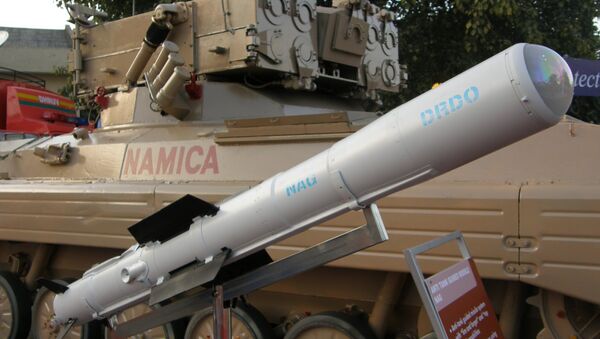Three successful tests were carried out on Sunday, with follow-up tests to further validate the capabilities of the Nag Missile Carrier (NAMICA) and mounted anti-tank guided missiles (ATGM) to be carried out on Monday, in Pokhran near the Pakistan border.
A Defence Research and Development Organisation (DRDO) official said: "the missiles were test-fired during both day and night, on Sunday during the trials".
The DRDO has been working on the Nag since 2009 and has spent approximately $47 million on its development. The missile with ‘fire and forget’ and ‘top attack’ capabilities, is deployed on a specially modified ICV BMP-2 vehicle called the ‘NAMICA’.
During Aero India 2019, the DRDO stated that Nag had successfully completed “Winter-use trials” in December 2018. The trials commenced after a protracted period of validation tests, in part due to the performance of the imaging infrared (IIR) seeker head.
The Nag is claimed to be one of few "fire-and-forget" anti-tank missiles, like the American Javelin, and the Israeli Spike. It is heavier than the Javelin and the Spike, both of which are man-portable.
Once launched, the Nag doesn't need to be guided, allowing the launcher to seek cover. The missile can use its autonomous onboard guidance to hit even a fast-moving tank. It uses indigenous image-seeking optical guidance, making it virtually jam-proof, unlike the infra-red seekers of the Javelin and Spike missiles.
The anti-tank guided missile has a lock-on-before-launch capability to a range of 4 km, the longest for any anti-tank missile in the world. US Javelin and the Israeli Spike lock-on-before-launch capability are limited to 2.5 km.
DRDO has also been developing man-portable and helicopter-launched anti-tank guided missile HeliNa for the air force. The DRDO was tasked with developing man-portable, anti-tank, guided missiles at the earliest. Defence forces received reassurance that this task would be completed by the DRDO last year.
The Indian Defence Ministry had cancelled the planned $500 million purchase of Spike anti-tank missiles from Israel's Rafael in favour of the DRDO's man-portable anti-tank guided missiles.
At present, India uses American, European, Israeli, Russian, and Soviet-made anti-tank missiles. The Nag is meant to phase out all of these foreign weapons as part of New Delhi's "Make in India" initiative.


